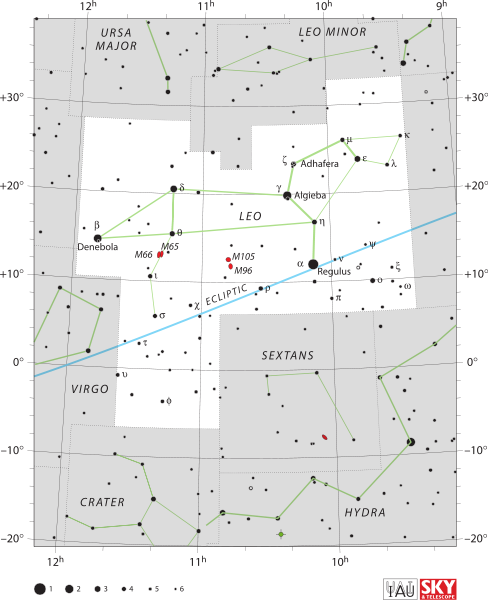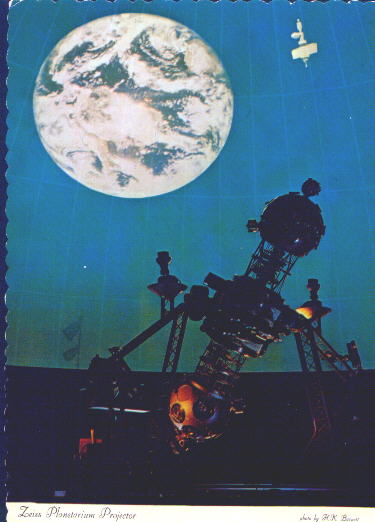
This map of part of the sky shows the location of the bright Star Regulus in the Constellation of Leo the Lion. In a rare occultation of a first-magnitude star, Regulus will be obscured by the Asteroid (163) Erigone early on the morning of March 20, which can be viewed by web-cast, for those not in the prime viewing area.
(Image Sources: International Astronomical Union, Sky and Telescope Magazine, and Wikipedia.org )
By Glenn A. Walsh
Reporting for SpaceWatchtower
In a rare occultation of a first-magnitude star, Regulus (magnitude +1.35), in the Constellation Leo the Lion, will be obscured by the Asteroid (163) Erigone Wednesday night / early Thursday morning (2014 March 20) at 2:07 a.m. EDT (6:07 Coordinated Universal Time).
This is the best and brightest occultation of a bright star, by an asteroid, ever predicted to occur over a major populated area. This occultation will occur only 10 hours and 50 minutes before the Vernal Equinox, the official beginning of the season of Spring in Earth's Northern Hemisphere.
This occultation can be seen, by telescope, binoculars,or even by naked-eye, in a narrow band that includes New York City, Fairfield County, Connecticut, as well as parts of Bermuda, New York State, and Ontario. For people not in this viewing area, the event will be web-cast, live, on the Slooh robotic telescope web site:
Slooh Robotic Telescope Web Site: Link >>> http://events.slooh.com/
Of course, the event will be recorded and can be viewed later on the web site, for those who can not stay up that late to see the event live.
The International Occultation Timing Association is asking members of the public in the prime viewing area to watch and time the event. It is estimated that Regulus could be blocked from view for as long as 14 seconds. Although this sounds like a very short time, and it is (so make sure you are ready to view at the precise time of the event, or you could miss it), it still is a comparatively long time for such a rare event.
Although the predicted time of the event is 2:07 a.m. EDT (6:07 UTC), remember that predictions are simply estimates. It would be a good idea to be watching Regulus well before the predicted time, to be sure you do not miss it.
By observing the timing of the occultation, citizen scientists can help professional scientists learn more about the Asteroid (163) Erigone. Once the occultation observation is made, it can reported to the International Occultation Timing Association on their web site at:
Regulus / Erigone 2014 Occultation Reporting Web Page:
Link >>> http://www.occultwatcher.net/regulus-erigone/
If you are in the prime viewing path, and you plan to observe and time the event, you may want to check that web page for more information ahead of time.
More on the occultation of Regulus by Erigone:
Link >>> http://www.asteroidoccultation.com/observations/RegulusOcc/
More on Star Regulus: Link >>> http://en.wikipedia.org/wiki/Regulus
More on Constellation Leo the Lion: Link >>> http://en.wikipedia.org/wiki/Leo_%28constellation%29
More on Asteroid (163) Erigone: Link >>> http://en.wikipedia.org/wiki/163_Erigone
Source: Glenn A. Walsh Reporting for SpaceWatchtower, a project of Friend of the Zeiss.
2014: 75th Year of Pittsburgh's Buhl Planetarium

Want to receive SpaceWatchtower blog posts in your inbox ?
Send request to < spacewatchtower@planetarium.cc >..
gaw
Glenn A. Walsh, Project Director,
Friends of the Zeiss < http://buhlplanetarium.tripod.com/fotz/ >
Electronic Mail - < gawalsh@planetarium.cc >
About the SpaceWatchtower Editor / Author: < http://buhlplanetarium2.tripod.com/weblog/spacewatchtower/gaw/ >
SpaceWatchtower Blog: < http://spacewatchtower.blogspot.com/ >
Also see: South Hills Backyard Astronomers Blog: < http://shbastronomers.blogspot.com/ >
Barnestormin: Writing, Essays, Pgh. News, & More: < http://www.barnestormin.blogspot.com/ >
SPACE & SCIENCE NEWS, ASTRONOMICAL CALENDAR:
< http://buhlplanetarium.tripod.
Twitter: < https://twitter.com/spacewatchtower >
Facebook: < http://www.facebook.com/pages/
Author of History Web Sites on the Internet --
* Buhl Planetarium, Pittsburgh:
< http://www.planetarium.
* Adler Planetarium, Chicago:
< http://adlerplanetarium.
* Astronomer, Educator, Optician John A. Brashear:
< http://johnbrashear.tripod.com >
* Andrew Carnegie & Carnegie Libraries:
< http://www.andrewcarnegie.
* Civil War Museum of Andrew Carnegie Free Library:
< http://garespypost.tripod.com >
* Duquesne Incline cable-car railway, Pittsburgh:
< http://inclinedplane.tripod.
* Public Transit:
< http://andrewcarnegie2.tripod.
No comments:
Post a Comment